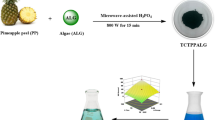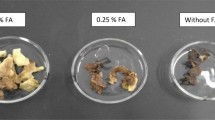Abstract
Recent discovery of humic acid (HA) in the free-living, brown algaPilayella littoralis has prompted a search for HA in other live plants. Marine algaeCodium fragile andMonostoma oxyspermum (greens),Chondrus crispus,Palmaria palmata andPolysiphonia lanosa (reds),Ascophyllum nodosum, Fucus vesiculosus andLaminaria saccharina (browns) andZostera marina (marine angiosperm) were investigated for their HA content. Only the brown algae and the marine angiosperm contained HA, which was extracted by a standard procedure augmented with necessary removal of alginic acid (where applicable). The isolated products were identified as HA by comparison of their analytical data, uv-visible, FTIR,1H NMR spectra and morphologies with those of authentic HA isolated from municipal compost.
Similar content being viewed by others
References
Chen Y, Senesi N, Schnitzer M (1977) Information provided on humic substances by E4/E6 ratios. Soil Sci. Soc. am. J. 41: 352–358.
Chen Y, Senesi N, Schnitzer M (1978) Chemical and physical characteristics of humic and fulvic acids extracted from soils of the Mediterranean region. Geoderma 20: 87–104.
Clapp CE (1996) Personal communication.
Firth FE (1969) Seaweeds in commerce. In: Encyclopedia of Marine Resources: Van Nostrand Reinhold, New York.
Flaig W, Beutelspacher H, Rietz E (1975) Chemical composition and physical properties of humic substances. In Gieseking JE (ed.), Soil Components. Volume 1, Organic Components. Springer-Verlag, New York: 4–7.
Ghabbour EA, Khairy AH, Cheney DP, Gross V, Davies G, Gilbert TR, Zhang X (1994) Isolation of humic acid from the brown algaPilayella littoralis. J. appl. Phycol. 6: 459–468.
Khairy AH (1989) Fractional extraction and characterization of humic acids from faeces of wild boar. De Natura Rerum 3: 229–237.
Khairy AH, El-Gendi SS, Baghdadi HH (1991) Humification in the gastrointestinal tract of rats. De Natura Rerum 5: 76–84.
Khairy AH, Davies G, Ibrahim HZ, Ghabbour EA (1996a) Adsorption of aqueous nucleobases, nucleosides and nucleotides on compost-derived humic acid. 1. Naturally occurring pyrimidines. J. phys. Chem. 100: 2410–2416.
Khairy AH, Davies G, Ibrahim HZ, Ghabbour EA (1996b) Adsorption of aqueous nucleobases, nucleosides and nucleotides on compost-derived humic acid. 2. Naturally occurring purines. J. phys. Chem. 100: 2417–2421.
MacCarthy P, Clapp CE, Malcolm RL, Bloom RR (1990) Humic Substances in Soil and Crop Sciences. American Society of Agronomy, Madison, Wisconsin.
Pierce Jr RH, Felbeck Jr GT (1972) A comparison of three methods of extracting organic matter from soils and marine sediments. Proc. Int. Meeting Humic substances, Nieuwersluis: 217–232.
Radwan A (1996) Isolation, characterization and processing of humic acids from live plants. Doctoral dissertation. Northeastern University, Boston, USA.
Radwan A, Willey RJ, Davies G, Fataftah A, Ghabbour EA, Jansen SA (1996) Supercritical fluid CO2 extraction accelerates isolation of humic acid from livePilayella littoralis (Phaeophyta). J. appl. Phycol. 8:
Rashig MA, King LH (1970) Major oxygen-containing functional groups present in humic and fulvic acid fractions isolated from contrasting marine environments. Geochim. Cosmochim. Acta 34: 193–201.
Scheffer F, Ziechmann W, Pawelke G (1960) Schonende Gewinnung naturlicher Huminstoffen mit Hilfe milder organischer Losungsmittel. Z. Pflanzenemahr. Dung. Bodenkd. 90: 58–67.
Senesi N, Miano TM (eds), (1994) Humic Substances in the Global Environment: Implications for Human Health, Elsevier, New York.
Stevenson FJ (1965) Gross chemical fractionation of organic matter. In: Black CA, Evans DD, White, JL, Ensminger LE, Clark FE (eds), Methods of Soil Analysis. Part 2: Chemical and Microbiological Properties. American Society of Agronomy, Madison, Wisconsin, p. 1414.
Whyte JNC (1988) Extraction of alginic acid from a brown seaweed. In: Lobban CS, Chapman DJ, Kremer BP (eds), Experimental Phycology: A Laboratory Manual, Cambridge University Press, New York: 168–173.
Ziechmann W (1993) Humic substances. BI Wissenschaftsverlag, Mannheim, Germany.
Author information
Authors and Affiliations
Additional information
Authors for correspondence
Rights and permissions
About this article
Cite this article
Radwan, A., Davies, G., Fataftah, A. et al. Isolation of humic acid from the brown algaeAscophyllum nodosum, Fucus vesiculosus, Laminaria saccharina and the marine angiospermZostera marina . J Appl Phycol 8, 553–562 (1996). https://doi.org/10.1007/BF02186335
Received:
Revised:
Accepted:
Issue Date:
DOI: https://doi.org/10.1007/BF02186335




